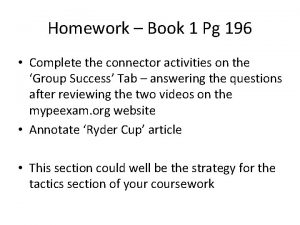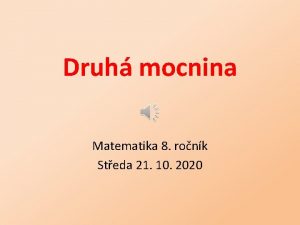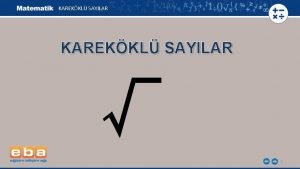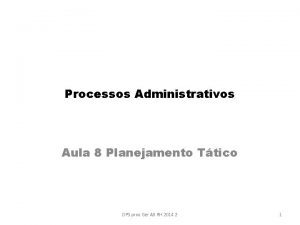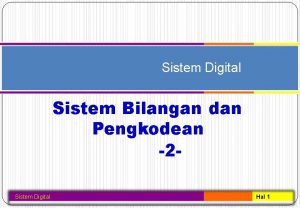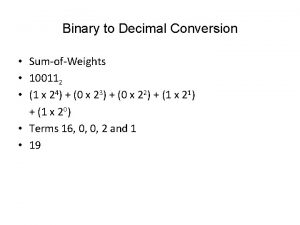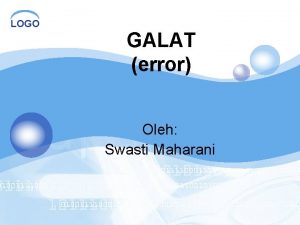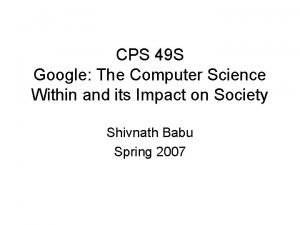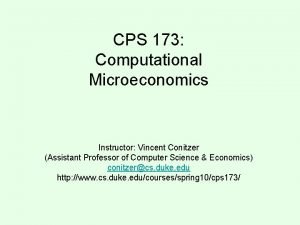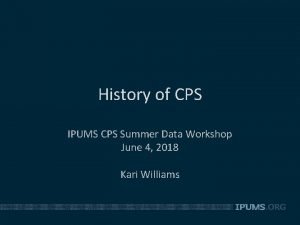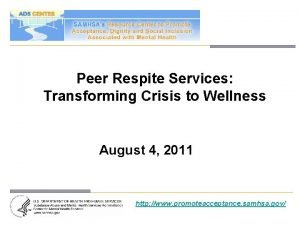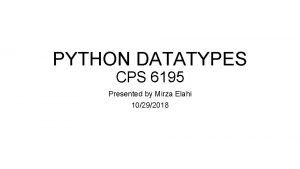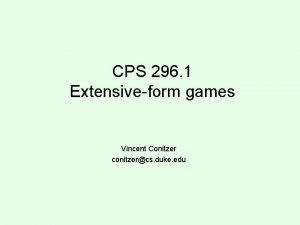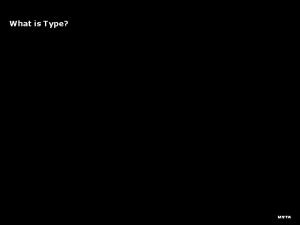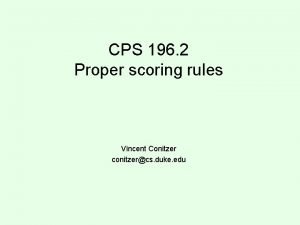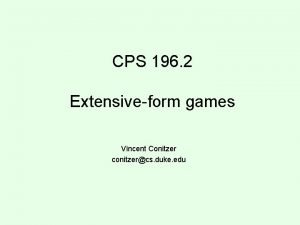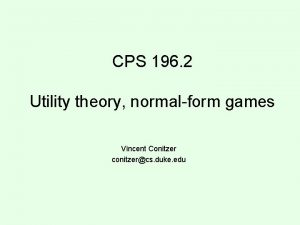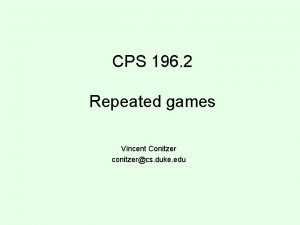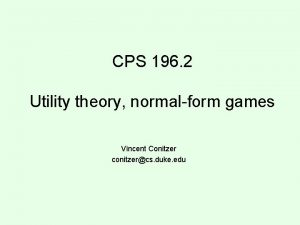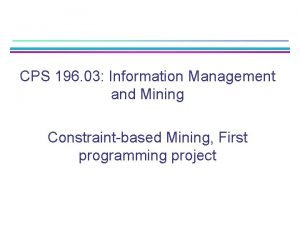CPS 196 2 Expressive negotiation over donations Vincent

























- Slides: 25

CPS 196. 2 Expressive negotiation over donations Vincent Conitzer conitzer@cs. duke. edu

One donor (bidder) u( u( )=1 ) =. 8 U=1

Two independent donors u( u( )=1 ) =. 8 U=1

Two donors with a contract u( u( )=1 ) =. 8 u( u( U =. 5 +. 8 = 1. 3 > 1 )=1 ) =. 8

Contracting using matching offers I’ll match any donation to u( )=1 u( ) = 1. 3

Limitations of matching offers • • One-sided Involve only a single charity

Two charities u( u( u( )=1 ) =. 8 ) =. 3 U = 1. 1 u( u( u( U = 1. 1 )=1 ) =. 3 ) =. 8

A different approach • Donors can submit bids indicating their preferences over charities • A center accepts all the bids and decides who pays what to whom

What do we need? • A general bidding language for specifying “complex matching offers” (bids) • Algorithms for the clearing problem (given the bids, who pays what to whom)

One charity • A bid for one charity: “Given that the charity ends up receiving a total of x (including my contribution), I am willing to contribute at most w(x)” Bidder’s maximum payment Budget w(x) x = total payment to charity

Bid 1 maximum payment $50 w(x) Budget $30 $10 x = total payment $100 $500

Bid 2 maximum payment w(x) $75 Budget $45 $15 x = total payment $100 $500

Current solution 45 degree line w(x) total $125 payment bidders are $75 willing to make max donated $25 max surplus x = total payment $100 $43. 75 $500

Tsunami event (Dagstuhl 05)

Problem with more than one charity • • • Willing to give $1 for every $100 to UNICEF Willing to give $2 for every $100 to Amnesty Int’l BUDGET: $50 wu(xu) $5000 xu wa(xa) $50 $2500 xa • Could get stuck paying $100! • Most general solution: w(x 1, x 2, …, xm) – Requires specifying exponentially many values

Solution: separate utility and payment; assume utility decomposes • Willing to give $1 for every $100 to UNICEF • Willing to give $2 for every $100 to Amnesty Int’l • Budget constraint: ua$50 u (x ) u (xu) a $50 1 util $100 xu $50 xa w(uu(xu)+ua(xa)) uu ( a 50 utils xu)+u ( xa)

The general form of a bid (utils) u 1(x 1) u 2(x 2) (utils) um(xm) … x 1 ($) x 2 ($) w(u 1(x 1) + u 2(x 2)+ … + um(xm)) u 1(x 1) + u 2(x 2)+ … + um(xm) (utils) xm ($)

What to do with the bids? • • Decide x 1, x 2, …, xm (total payment to each charity) Decide y 1, y 2, …, yn (total payment by each bidder) y 1 x 1 y 2 x 2 • Say x 1, x 2, …, xm ; y 1, y 2, …, yn is valid if – x 1+ x 2 + … + xm ≤ y 1 + y 2 + …+ yn (no more money given away than collected) – For any bidder j, yj ≤ wj(uj 1(x 1) + uj 2(x 2) + … + ujm(xm)) (nobody pays more than they wanted to)

Objective • Among valid outcomes, find one that maximizes • Total donated = x 1+ x 2 + … + xm y 1 x 1 y 2 x 2 • Surplus = y 1 + y 2 + …+ yn - x 1 - x 2 - … - xm y 1 x 1 y 2 x 2

Avoiding indirect payments

No payments to disliked charities

Hardness of clearing • NP-complete to decide if there exists a solution with objective > 0 • That means: the problem is inapproximable to any ratio (unless P=NP)

General program formulation • Maximize – x 1+ x 2 + … + xm , OR – y 1 + y 2 + …+ yn - x 1 - x 2 - … - xm • Subject to – y 1 + y 2 + …+ yn - x 1 - x 2 - … - xm ≥ 0 – For all j: yj ≤ wj(uj 1 + uj 2 + … + ujm) – For all i, j: uji ≤ uji(xi) nonlinear

Concave piecewise linear constraints l 1(x) l 2(x) l 3(x) b(x) y ≤ l 1(x) y ≤ l 2(x) y ≤ l 3(x) x

Linear programming • So, if all the bids are concave… – All the uji are concave (utils) – All the wj are concave ($) uji(xi) wj(uj) xi ($) uj (utils) • • Then the program is a linear program (solvable to optimality in polynomial time) Even if they are not concave, can solve as MIP
 Lcif grant program
Lcif grant program An elementary school classroom in a slum theme
An elementary school classroom in a slum theme For lives that slyly turn
For lives that slyly turn Homework 196
Homework 196 Perhatikan gambar kubus ijkl
Perhatikan gambar kubus ijkl √54756
√54756 Odmocnina 196
Odmocnina 196 Cube root of 1200
Cube root of 1200 Irrasyonel sayılar
Irrasyonel sayılar Tipos de planejamento
Tipos de planejamento 196 883-dimensional monster
196 883-dimensional monster Bisp 195 ucsd
Bisp 195 ucsd Nilai binar dari nilai bilangan decimal 196 . ?
Nilai binar dari nilai bilangan decimal 196 . ? What is the decimal value of 11012?
What is the decimal value of 11012? Contoh pembulatan
Contoh pembulatan Taking over navigational watch
Taking over navigational watch Over the mountain over the plains
Over the mountain over the plains Siach reciting the word over and over
Siach reciting the word over and over Sgoogle slides
Sgoogle slides Cps 173
Cps 173 Cps 1200
Cps 1200 Ipums cps
Ipums cps Vincent conitzer
Vincent conitzer Peer respite centers
Peer respite centers Cps test
Cps test Cps
Cps



